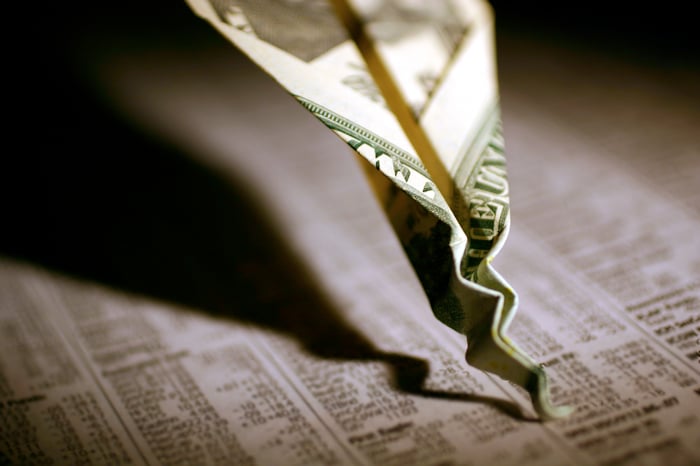Despite a global pandemic and historic volatility over the past year, investors have a lot to be thankful for.
After losing 34% of its value in less than five weeks during the first quarter of 2020, the benchmark S&P 500 (^GSPC -0.46%) bounced more than 75% higher from the bear market low set on March 23. In no particular order, investors have been encouraged by:
- The Federal Reserve's willingness to undertake unlimited quantitative easing measures to buoy financial markets, as well as its historically dovish stance on lending rates;
- The federal government's more than $3 trillion in fiscal stimulus passed in 2020; and,
- The expediency with which several coronavirus disease 2019 (COVID-19) vaccines were developed and introduced in the United States.

Image source: Getty Images.
Unfortunately, the stock market's incredible 11-month bull run may come to a crashing halt. Although it's impossible to predict stock market crashes and corrections with any true precision, there are more than enough clues to suggest that trouble is brewing. Over the next three months, three catalysts stand out as particularly concerning, and more than capable of causing a crash.
1. Valuations are at nearly two-decade highs
Arguably the single greatest concern for the stock market is valuation, which is something I've been harping on for months.
As of Feb. 22, the Shiller S&P 500 price-to-earnings (P/E) ratio -- a P/E ratio based on average inflation-adjusted earnings from the previous 10 years -- stood at 35.30. That's more than double its average reading of 16.78 over the past 150 years, and it's the highest the Shiller P/E ratio has been for the S&P 500 since the dot-com crash two decades ago.
There have only been five instances in the 150-year history of the Shiller S&P 500 P/E ratio where a bull market rally has sustainably taken it above 30: The Great Depression, the dot-com bubble, Q4 2018, the COVID-19 crash of Q1 2020, and currently. In each of the previous four instances, the S&P 500 lost between 20% and 89% of its value. Admittedly, the Great Depression was a unique scenario that would be unlikely to play out today. Nevertheless, bad things have historically been in the cards for the S&P 500 when the Shiller P/E ratio gets north of 30.

Image source: Getty Images.
2. COVID-19 variants/vaccination holdouts are concerning
Secondly, it wouldn't be smart to overlook COVID-19 as an ongoing concern.
Much of the news we've received on the coronavirus front has been good. Two vaccines have been granted emergency-use authorization in the U.S., with a handful of other drug developers reporting positive late-stage results from their vaccine studies. As of Feb. 22, more than 63 million doses had been administered, with nearly 6% of the adult population receiving the two-dose inoculation. The U.S. is currently administering around 1.8 million vaccines each day.
The problem is that the virus continues to mutate, with new and potentially more dangerous strains emerging. While some of the vaccines work well to contain or halt the spread of these variants, not all variants are the same. The point being that if the vaccination campaign doesn't occur quickly enough, these variants could be dominant in the U.S., thereby minimizing the effectiveness of the approved vaccines.
At the same time, many Americans are choosing to either not get the vaccine or taking a wait-and-see approach. Late last month, a survey from the Kaiser Family Foundation found that 1 in 8 people definitely won't get it, with another 31% waiting to see how it works on the inoculated. If too few people receive the vaccine, herd immunity will be pushed further down the road.

Image source: Getty Images.
3. Rising Treasury yields portend trouble for spoiled homeowners and prospective buyers
A third market crash-causing concern is that the multiyear housing boom could dry up at the drop of a pin.
Without getting too far into the weeds, current homeowners and prospective buyers have been driven by historically low lending rates. Though the Fed doesn't directly control mortgage rates, there's been a fairly tight correlation between mortgage rates and 10-year Treasury yields for a long time. Last year, 10-year Treasury yields hit roughly 0.5%, paving the way for historically low mortgage and refinance rates, as well as tempting homeowners to take equity out of their homes.
However (cue the scary music), the yield curve has been steepening at an incredibly fast pace in recent weeks. On Feb. 22, it hit 1.37%, which suggests that mortgage and refinance rates are going to climb in the weeks and months to come. Even though rates could rise 100 basis points overnight and still be well below historic averages, homeowners and prospective buyers have been spoiled by historically low lending rates for years. In two instances in the last decade when mortgage rates rose by approximately 100 basis points relatively quickly, new mortgage and refinance applications fell off a cliff.
The housing boom has been perceived as a wealth-creating bright spot that's given some homeowners quick access to cheap capital. That access could disappear quickly if Treasury yields keep rising.

Image source: Getty Images.
Stay focused on the long term
No matter what happens over the next three months, the one number that investors should keep in mind is 38-for-38.
Since the beginning of 1950, there have been 38 stock market corrections or crashes in the S&P 500 totaling at least 10%. In every single instance, the point losses associated with these moves lower were eventually erased by a bull market rally. In many instances, it took mere months to say goodbye to short-term pessimism. The point is that crashes and stock market corrections are both 1) normal parts of the investing cycle and 2) opportunities to load up on high-quality companies at a discount.
With uncertainty still high on Wall Street, it wouldn't be a bad idea to have some cash at the ready.




